When fishing in freshwater most sportfishing is done with artificial lures. This is not necessarily because artificial lures are the best bait to be using. In many cases using live bait or fresh bait will out fish artificial lures. Most freshwater anglers know that worms will catch a larger variety of fishing including bass, perch, walleye, crappie, and catfish.
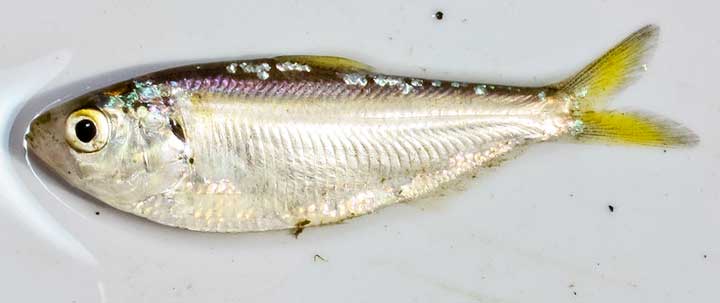
Image Source: Wikimedia Commons.
In freshwater, I like to use Alewife for hybrid striped bass, creek chubs for bass, fathead Minnows for perch, crappie, and walleye. Worms, creature baits, frogs, and crayfish also work great in freshwater. Live bait does not cover as much water but can get fish excited about the potential meal.
The disadvantage of live bait is that you have to catch it or buy it each time you go fishing. Sometimes catching the bait can be as fun as catching the targeted species. Advantages of live bait are that it has natural motion, a strong scent, and works well at night. It can also be slowly fished without making excessive splashing which can spook fish.
Types of Freshwater Baitfish
1. Creek Chub
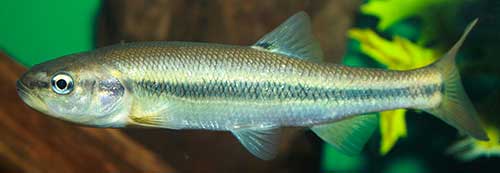
Image Source: Wikimedia Commons.
Creek chubs are found in many creeks, streams, and ponds in the United States. I think of them as little mini bass. Creek chubs can grow to 12 inches in length but it is very common to find them 2-6 inches in length. These work best as bait in ponds that streams that naturally have creek chubs. If you want to catch big bass in small ponds using creek chubs is a good option. For kids, it is also fun to catch and release creek chubs.
Since creek chubs are like bass they will bite bait but the hook needs to be small. Using a trout hook and piece of worm is a great way to catch a creek chub. A great place to find creek chubs is in large drainage ditches or a small creek. These minnows can also be caught with a minnow trap, seine net, hand net, or cast net if that is legal in the area.
2. Alewife

Image Source: portal.ct.gov.
Alewife are a schooling baitfish found in freshwater lakes. This is a type of shad that works well as bait for most predator fish. Alewife are a well-known baitfish in the great lakes. Although they are invasive to these waters they are the dominant food source for many fish such as lake trout, coho salmon, and king salmon.
Even in small lakes, Alewife can be found in large numbers. For lakes with striped bass or hybrid striped bass, Alewife is a good bait. In lake Author in Pennsylvania, we throw a cast net to catch the bait. Then we place the bait on a bobber of float and fish at night. This is very fun and effective during the summer months.
In the video above I show how to throw a cast net to catch bait. In freshwater lakes, a cast net permit is often required. This will typically be for a certain size net as well. Alewife can be caught even with small cast nets and the mesh size should be 3/8 inch or smaller. Cast nets are widely used to catch saltwater baitfish.
3. Threadfin Shad
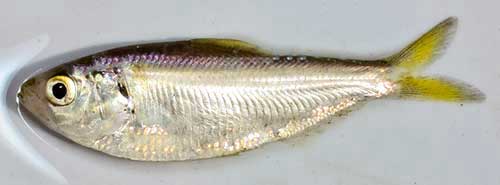
Image Source: Wikimedia Commons.
Threadfin shad are found in lakes, rivers, and reservoirs. It is a schooling baitfish that can grow to be 8-inches in length. This type of shad is a food source for striped bass, hybrid striped bass, largemouth bass, smallmouth bass, and catfish.
A threadfin shad will have an elongated dorsal fin that looks like a thread coming off its back. Gizzard shad also have an elongated dorsal fin but can grow up to 16 inches. These types of shad will not bite on hooks. A cast net would work to catch them it if is legal in the area. If live bait is not an option, there are many good shad swimbaits and crankbaits that are a good imitation for shad.
4. Fathead Minnow
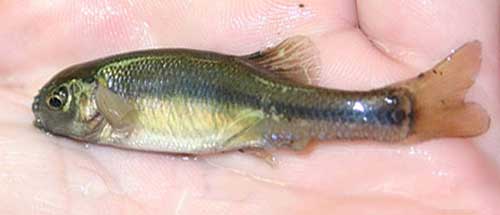
Image Source: Wikimedia Commons.
Fathead minnows are very common in ponds and lakes, in the USA and Canada. These fish are pretty small and can grow up to 4 inches in length. Fathead minnows are a good live bait cause they stay alive well in the bait bucket. They can live in low oxygen content water, polluted water, and have a wide diet eating both plants, insects, and plankton. If you are looking for a baitfish to add to a pond this is a good option, although bass may eventually eat them all. The rosy-red minnow is a type of fathead minnow that is popular as an aquarium fish.
If these are in a pond they can be caught with a hand net, seine net, or minnow trap. These baits are commonly used to catch crappie, walleye, and perch. For this reason, they are sold in many bait shops. The minnows will also be eaten by bass, catfish, northern pike, and pickerel.
5. Suckerfish
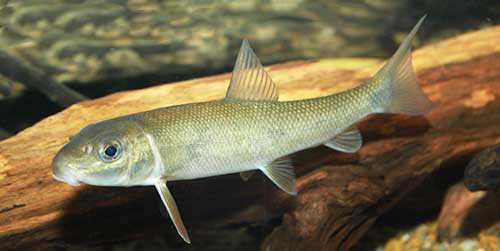
Image Source: Wikimedia Commons.
White suckers are common in streams and rivers. Adults can grow up to 18 inches long but are more commonly 10-12 inches in length. Suckerfish can be caught on a rod and reel. The key is to have the bait right on the bottom. Worms are a good bait for sucker fishing. The fish tend to be sitting along edges of fast-moving water similar to trout. For this reason, adequate weight should be used to keep the bait on the bottom.
Suckerfish can also be caught with a seine net or cast net where allowed. Really small suckers can be good trout bait. Other types of fish suckers that will work well on are bass, walleye, northern pike, and musky. Placing them on a float so they are not right on the bottom is a good idea. These are found in similar areas as creek chubs.
6. Bluegill
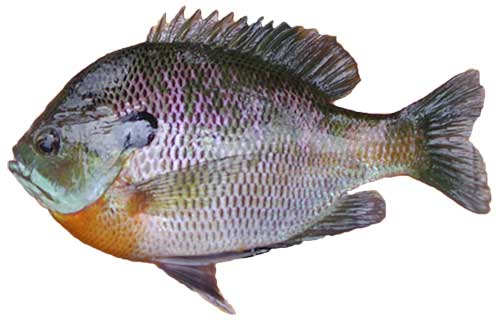
If you have ever fished a pond you know that bluegill are a very common fish. These fish are actually in the family of sunfish but are their own species. Large bluegill are fun fish for kids to catch. In a pond or lake, cast a bobber out with a worm and bluegill should find it quickly. These are also an important food source in a lake for bass, panfish, catfish, pickerel, northern pike, and musky, all of which eat bluegill. Large bluegill are not a good bait but small bluegill can be good bait. However, very few anglers actually use bluegill as bait as there are many effective and easier baits to use.
People with small lakes and ponds often discuss whether bass would do better in a pond with our without bluegill and sunfish. Some people complain the bluegill eat all the bass eggs and small bass once they hatch. Also, the sunfish eat all the zooplankton baby bass need and the zooplankton helps to eat the algae in the pond. It is possible for this to be the case but most lakes and ponds naturally strike a good balance of bass, bluegill, and sunfish. Ponds without bluegill are actually quite rare are usually also loaded with bass. It is important that the structure in the pond provides protection and breeding grounds for bass and bluegill.
7. Sunfish
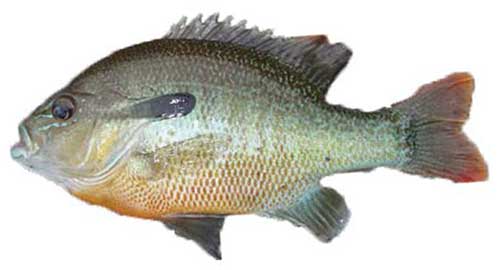
In ponds and lakes, there are typically lots of fish that look like bluegill so many people just call them all bluegill. The fact is there are many different types of sunfish including bluegill, redbreast sunfish, green sunfish, spotted sunfish, redear sunfish, pumpkinseed sunfish, dollar sunfish, longear sunfish, orange-spotted sunfish, and warmouth. These fish grow to be between 5-12 inches in length and can weigh over 4 pounds. Sunfish species can lay between 1,000 and 100,000 eggs which means for every big fish there are lots of little fish that become food for larger predator fish and other sunfish.
Sunfish can be caught with worms, bread, hotdogs, or pretty much anything that can be put on a hook. Smaller sunfish can be caught in a hand neet, seine net, cast net, or minnow trap. Typically smaller sunfish are found in thick vegetation. It is a good bait to use for striped bass, hybrid striped bass, largemouth bass, pickerel, northern pike, musky, and catfish.
8. Perch
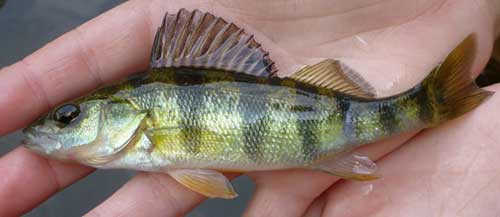
Image Source: Matt Tillett.
Yellow perch are abundant fish in many rivers, lakes, and reservoirs. They can grow up to 18-inches in length but most adults are between 4-10 inches in length. The fish usually lay between 10,000 and 40,00o eggs so there will be lots of predator fish trying to eat them. Since perch is considered a gamefish it is not allowed to be used as live bait in some states.
Many swim jigs and crankbaits are made to look like small yellow perch. This is my favorite pattern of a deep-diving plug to use when fishing for smallmouth bass. When catching perch in shallow water it is not uncommon to have norther pike or musky follow the fish in or attack the perch. This is also good bait for largemouth bass, walleye, pickerel, and catfish.
9. Golden Shiner
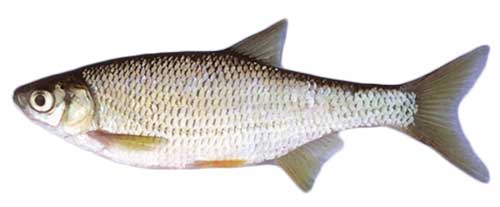
Image Source: portal.ct.gov.
Golden shiners are found in lakes, and ponds throughout the USA from Florida to the northern great lakes. They are one the most common fish to add to small ponds and do well in warm and cold water. Their appearance looks like a mini-carp in my opinion. A full-size golden shiner is 3-5 inches long but they can get bigger in larger lakes and ponds.
Golden shiners have a wide diet and will eat everything from algae to worms. These baits can be caught using a small piece of bait such as bread or worm on a small hook. Adult golden shiner a bit too large for most minnow traps but smaller ones can be caught that way. A cast net can work but they are often found in areas with lots of weeds which can make it difficult. Golden shiners make great bait for monster bass, hybrid striped bass, striped bass, and catfish.
Thie video above shows how to catch golden shiners in a small pond in Alabama using worms for bait.
10. Common Shiner

Image Source: portal.ct.gov.
Lots of fishermen say they are fishing with shiners but that is often just a general term for minnows. Common shiners are pretty large and adults are around 5 inches in length. These are naturally found in streams, rivers, and lakes in the northeast and mid-west. They are found in simar areas as creek chubs.
Common shiners eat plants, insects, and worms. These can be caught on a small hook, minnow trap, seine net, or cast net. Once caught they make good live bait for bass, pickerel, northern pike, catfish, and walleye.
11. Northern Redbelly Dace
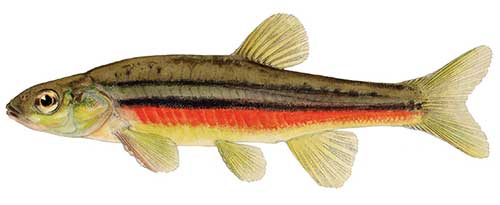
Image Source: Wikimedia Commons.
The northern redbelly dace is a small minnow that grows to be about two inches in length. These are found in the northern United States from Montana to Maine. It lives in small creeks, streams, rivers, and lakes. For food, it eats algae, insects, or zooplankton. There is also a very similar southern redbelly dace that lives as far south as Arkansas and Alabama.
These can be caught using micro fishing techniques with a tiny hook and piece of bait. Using a seine net in a stream is another good option. Redbelly dance can be one of the more difficult minnows to catch. It is good bait for walleye, trout, and panfish. The redbelly of the fish is only present on the males during the breeding season.
12. Salamanders and Newts
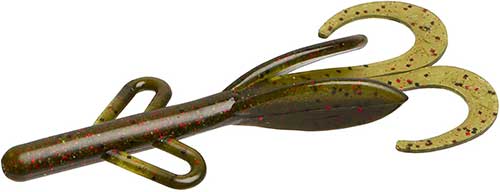
Salamanders and newts are found in creeks, streams, rivers, ponds, and lakes. There are many different types of salamanders and newts and their behavior varies significantly. Salamanders can breathe through thier gills, lungs, or skin. Some salamanders have all three respiration systems while others may only be able to breathe through their skin. I always wondered how newts could breathe underwater without gills. Their skin acts as gills and can pick up dissolved oxygen in the water.
While it is easy enough to catch salamanders I never use them as live bait as this seems to mean. Also, there are many great artificial baits such as my favorite bass lure, the baby brush hog. When fishing in water less than 5 feet and near lilly pads using salamander creature baits are a great option.
13. Frogs
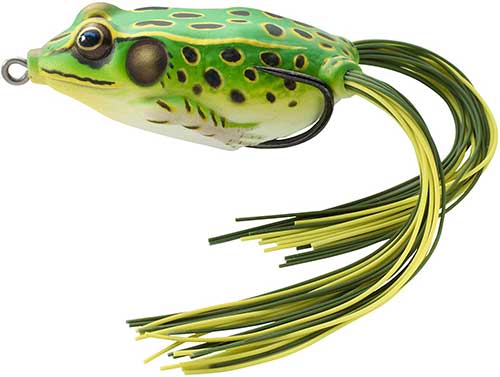
Frogs are actually a large food source for bass in ponds and small lakes. If you can hear lots of frogs in the evening chances are frogs will be a good bait to use. Once I remember walking by the edge of a small lake and frogs were jumping in and immediately being eaten by bass. I never use live frogs as bait but there are many good imitation baits on the market.
Typically these are fished near the shore or in thick weeds on the surface. Short tugs give the frog a motion similar to a frog kicking. Frog baits are best used close to dusk or even at night. Fishing a frog bait is super fun cause you get to see the bass hit the bait at the surface. Sometimes it is even startling. Both small and big bass can be caught on frogs but they do have a reputation of catching monster bass.
14. Tadpoles
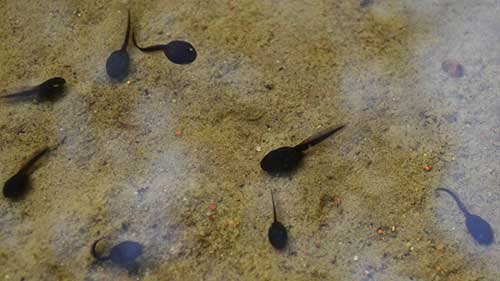
In ponds and lakes with lots of tadpoles, they can be good bait for bass. Tadpoles come in many different sizes depending on the type of frog or toad species they will become. Generally, toad tadpoles are very small and bullfrog tadpoles are the largest. Frogs and toads sometimes lay their eggs in small ponds and puddles so fish will not be able to eat them.
There are small tadpole soft plastics that can be used if you notice the bass are feeding on tadpoles. I have seen lakes with tons of tadpoles and bass were not actively feeding on them. However, at certain times of the day, I am sure it happens. Whether or not this is good bait depends on if the bass are use to feeding on them. If not you are probably better off with worm, crayfish, and salamander creature baits.
15. Crayfish
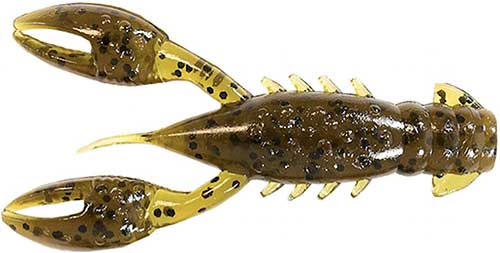
Crayfish are a favorite food of both smallmouth bass and largemouth bass. They also work well to catch walleye, perch, and trout. Crayfish live on the bottom in rocky areas of streams, lakes, and ponds. Using a jighead with crayfish bodies is one of the most popular lures used when bass fishing. This allows for ledges and deep water to be fished where other bass techniques do not work well. Fishing in deep grass beds with crayfish jigs is also worth trying.
It is somewhat rare for people to use live crayfish for bait. Live crayfish is a fantastic bait though. Often it is irresistible to any fish that sees it. Crayfish are not that hard to catch. It can be done by lifting up rocks and using a hand net. My favorite way to catch lots of crayfish is with a seine net in a small creek, stream, or river. People even catch them this way to eat the crayfish themselves.
16. Leeches
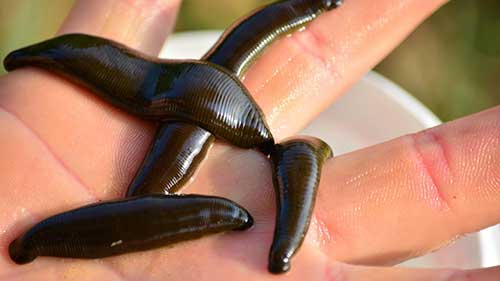
There are over 600 types of leeches in North America. Most of these are not blood-sucking leeches but feed on other insects, worms, snails, and remains of fish. However, when most fishermen are talking about leeches there are talking about blood-sucking leeches. They are found in the Northern States in the USA such as New Hampshire and Michigan. Leeches are very abundant in Saskatchewan, Manitoba, and Ontario Provinces in Canada.
For bait, these work great for walleye, largemouth bass, smallmouth bass, perch, sunfish, and bluegill. Leeches are best known for being the best bait for walleye in the early spring and summer in Canada. The bait is hooked by the sucker end where it is free to swim. Leeches can be caught in a leech trap that is most often baited with beef liver. There are also many leech imitation baits including Berkely Gulp Leech.
17. Worms

Last but not least, worms! These can be red worms, earthworms, or nightcrawlers. This is one of the best baits for most freshwater fish including bass, walleye, perch, bluegill, sunfish, catfish, and trout. Worms can be fished with a bobber suspended in the water or right on the bottom. The only problem with worms is that little fish will often come and bite the worm apart. This is a problem when trying to catch larger fish.
Worms can be caught by lifting up rocks, lifting up wood, or going out after heavy rain and find them lying on the ground. Many stores, bait shops, and gas stations also sell worms for bait. If you do not like placing the worm onto the hook soft plastic worms are also very effective. The advantage of fake worms is that small fish can not tear them as easily and there are lots of good color options. Zoom trick worms around 6.5 inches is one of my favorite worm bait. These work very well in lily bait and shallow weed beds for bass.
Captain Cody has worked on charter fishing boats in the Florida Keys, Virgin Islands, and Alaska. Growing up in Pennsylvania Cody has also done extensive freshwater fishing including bass fishing tournaments. Cody strives to provide detailed information about the best fishing gear and tactics to help both novice and experienced anglers have a more productive and enjoyable time on the water. Cody also has a background in aerospace engineering and neuroscience but really only takes pride in being good at one thing and that is fishing!
